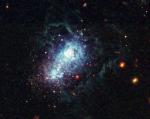
|
Astronomy Picture Of the Day (APOD)
 M87 s Energetic Jet
M87 s Energetic Jet
10.12.2004
An energetic jet from the core of giant elliptical galaxy M87 stretches outward for 5,000 light-years. This monstrous jet appears in the panels above to be a knotted and irregular structure, detected across the spectrum, from x-ray to optical to radio wavelengths.
 Debris Disks Surround Distant Suns
Debris Disks Surround Distant Suns
9.12.2004
In this dramatic artist's vision, debris along the outer reaches of a planet forming disk orbits in the glare of a distant sun. But inset are actual images of such disks around two nearby stars - AU Microscopii (top left; edge-on) and HD107146 (right: face-on) - as seen by the Hubble Space Telescope.
 Jupiter and the Moon s Shadowed Horizon
Jupiter and the Moon s Shadowed Horizon
8.12.2004
Early Tuesday morning, December 7th, June Croft thought the southeastern sky above Atmore, Alabama, USA was beautiful. Watching the Moon rise through gossamer clouds, she noted, " ... the crescent Moon looked like it was held in the sky by a star just off its shadowed horizon." What was that star?
 In the Center of the Heart Nebula
In the Center of the Heart Nebula
7.12.2004
What powers the Heart Nebula? The large emission nebula dubbed IC 1805 looks, in whole, like a human heart. The nebula glows brightly in red light emitted by its most prominent element: hydrogen. The red glow and the larger shape are all created by a small group of stars near the nebula's center.
 A Strange Streak Imaged in Australia
A Strange Streak Imaged in Australia
6.12.2004
Meteor experts don't think it's a meteor. Atmospheric scientists don't think it's lightning. The photographer insists that the streak and flash on the above image has not been created digitally. So what is it? Nobody is sure.
 Filaments Across the Sun
Filaments Across the Sun
5.12.2004
Two unusually long filaments crossed part of the Sun last week. The filaments are actually relatively cool and dark prominences of solar plasma held up by the Sun's magnetic field but seen against the face of the Sun. Filaments typically last a few weeks before falling back.
 Kembles Cascade
Kembles Cascade
4.12.2004
A picturesque chain of unrelated stars is visible with strong binoculars towards the constellation of Camelopardalis. Known as Kemble's Cascade, the asterism contains about 20 stars nearly in a row stretching over five times the width of a full moon.
 Reflecting Merope
Reflecting Merope
3.12.2004
In the well known Pleiades star cluster, a star's light is slowly destroying this wandering cloud of gas and dust. Above, the star Merope lies just off the upper left edge of this picture from the Hubble Space Telescope.
 I Zwicky 18: Young Galaxy
I Zwicky 18: Young Galaxy
2.12.2004
The Milky Way is an ordinary 12 billion year old spiral galaxy, and even our middle-aged Sun is pushing 4.5 billion years. But all the stars in dwarf galaxy I Zwicky 18 are much younger.
 Mimas, Rings, and Shadows
Mimas, Rings, and Shadows
1.12.2004
Caught in sunlight, icy moon Mimas shines above a broad shadow across gas giant Saturn. In this remarkable image from the Cassini spacecraft, tiny Mimas is at the upper right. The broad shadow across...
|
January February March April May June July August September October November December |
|||||||||||||||||||||||||||||||||||||||||||||||||